Cellufine SPA-HC is the resin immobilized alkali resistance protein A ligand. The resin features low back pressure attributed to its crosslinking technology and has high porosity in order to achieve high mass transfer of antibodies. The resin is created using unique bead manufacturing technology developed through 40th years of business in chromatography, guarantying high dynamic binding capacity at high flow rates.
Protein A Media

Cellufine SPA-HC
Cellufine SPA-HC is categorized as Protein A media for antibody purification. Protein A media is usually selected as the first of two steps in antibody purification chromatography and proves to be crucial for the overall purification process. Cellufine SPA-HC is a high-performance media which allows for purification of a large volume of culture supernatant in short period of time. The resin provides:
- High dynamic binding capacity at a high flow rate.
- Low back pressure at a high flow rate.
- Reusability.
-
-
Property Characteristics Ligand Alkali-stable rProtein A affinity ligand produced in E.coli Matrix Highly cross-linked cellulose beads Particle size Average 70 µm diameter Ligand coupling method Coupling via formyl groups on resin Flow velocity ≧650 cm/h (0.3 MPa) with 10 cmID x 20 cmL Column in water at 24 ℃ Dynamic binding capacity (DBC) ≧ 70 mg /ml (DBC C10 with Polyclonal IgG) Recommend CIP 0.1 M NaOH Temperature stability 4 - 50 ℃ No significant change in performance after 1-week storage. Storage 2 - 8 ℃ in 20 % (v/v) ethanol Chemical stability No significant change in performance after 1-week storage in 30 % (v/v) isopropanol, 20 – 70 % (v/v) ethanol, 8 M Urea, 6 M Guanidine-HCl or 0.1 M Acetic acid. pH working range 3-12 -
- Coupled with an alkali resistance rProtein A ligand
- Excellent dynamic binding capacity
- Low back pressure at high flow rate
- Robust performance independent of monoclonal antibody
- Reduced bead diameter
- Excellent reusability
Affinity Chromatography Media
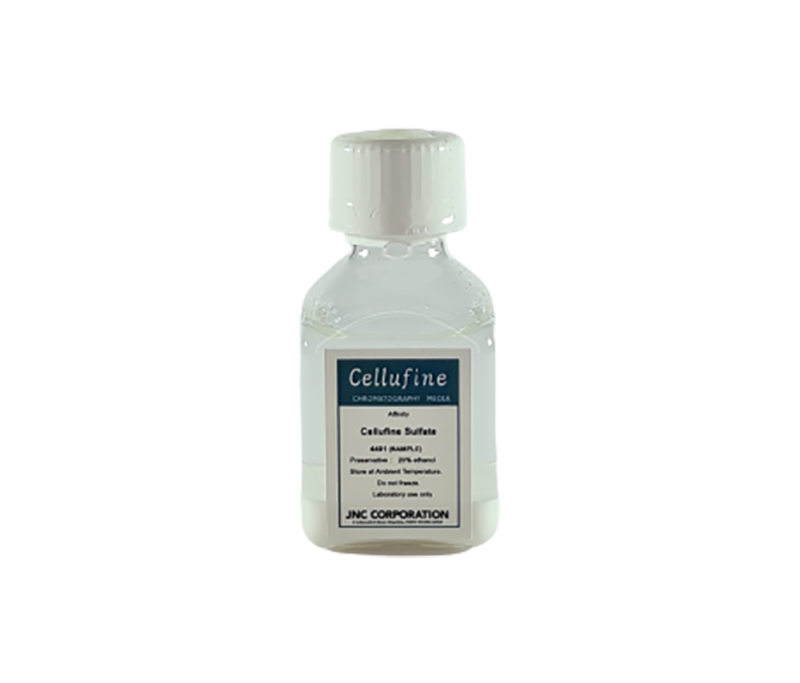
Cellufine Sulfate
Advances in vaccines and clinical diagnostics have created an increasing demand for large volumes of highly purified and concentrated virus and viral or microbial antigens. Cellufine Sulfate affinity media is a simple, rapid and effective means for concentration, purification and depyrogenation of these important products. Cellufine Sulfate eliminates cumbersome, time-consuming and potentially unsafe classical ultra-centrifugation and density gradient methods. It can also provide a significant improvement in concentration and purity.
-
Cellufine Sulfate can reduce or eliminate the expense, ligand leakage and reproducibility problems associated with immobilized dextran sulfate, chondroitin sulfate or heparin. Elution of the bound product is affected through simple stepwise or gradient increases in ionic strength. Simultaneous concentration and purification improve yield, reduces processing steps, time and costs. The resin resists compression, providing rapid flow for high-speed processing, even in large columns, making it easily scalable.
-
Property Characteristics Support Matrix Cellulose Particle Size ca. 40 – 130 µm Particle Shape Spherical Gel Exclusion Limit 3kD Activated Group Sulfate Ester Total Sulfur >700 µg/g dry Protein Lysozyme: >3 mg/ml Hepatitis B Surface Antigen: 7 mg/ml Environmental Resistance Resistant to 0.1M NaOH, 0.1 % of 37 % Formalin Operating Pressure < 2 bar (30 psi) Autoclavable In suspension at neutral pH; 30 min at 121 °C Supplied Suspension in 20 % Ethanol -
- Affinity for a wide range of live, killed or disrupted viruses, viral or microbial antigens and heparin-binding proteins.
- Closed column operation assures safety and product sterility
- Endotoxins do not bind, allowing a rapid and contaminant free depyrogenation.
- Rigid, high-strength beads.
- Autoclavable
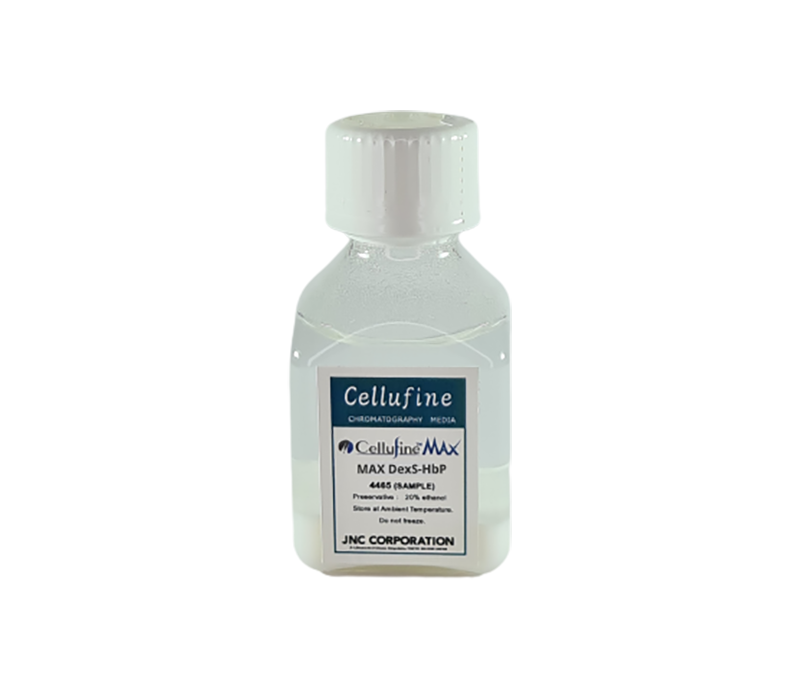
Cellufine MAX DexS-HbP, Cellufine MAX DexS-VirS
We offer two different Cellufine MAX DexS resins, surface modified with different lengths of Dextran Sulfate polymer; a) DexS-HbP developed for purification of heparin binding proteins. and b) DexS-VirS, for purifying virus and virus like particles especially having affinity for heparin. Both resins have been developed to improve the protein or virus capture efficiency of existing resins by employing a pseudo affinity mimetic polymer surface based on Dextran Sulfate. The cross-linked cellulose base bead has been optimized for high flow applications and is fully compatible up to 0.5 M NaOH for CIP.
-
Performance Characteristics Product name Cellufine MAX DexS-HbP Cellufine MAX DexS-VirS Ligand Dextran sulfate Matrix Cross-linked cellulose beads Particle size 40 -130 μm (ca 90μm) Sulfur contents ≥ 36 μmol/mL ≥ 74 μmol/mL Lysozyme adsorption capacity ≥ 50 mg/mL ≥ 56 mg/mL pH stability 3 - 12 Operating pressure < 0.3 MPa

Cellufine ET clean L & Cellufine ET clean S
The Cellufine™ ET clean media are poly(ε-lysine) immobilized Cellufine™ (cellulose spherical beads) and are categorized as Affinity Chromatography Media for Endotoxin Removal. These beads efficiently bind and remove endotoxins from your sample solution. The poly(ε-lysine) is a microbial poly(amino acid) that consist of 25-35 lysine residues produced by Streptomyces albulus. The poly(ε-lysine) act as the ligand and the cellulose beads act as matrix.
-
The Cellufine™ ET clean endotoxin removing beads were developed jointly by Kumamoto University and Chisso. The poly(ε-lysine) was immobilized onto chloromethyloxirane-activated cellulose beads. The beads are stable affinity beads that are resistant to the cleanup solutions, which include 0.2 M sodium hydroxide and 2 M sodium. The Cellufine™ ET clean can remove endotoxin from a cellular product solution at physiological pH, ionic strength of μ = 0.02-1.0, and temperature of 0° -25C°
-
Name Supplied Wet Bead Diameter Pore Size* Cellufine™ ET clean S a slurry in 20 % ethanol ca. 40-130 μm Mlim 2000 Cellufine™ ET clean L a slurry in 20 % ethanol ca. 40-130 μm >Mlim 2x106 *The pore size (molecular weight exclution; Mlim) of the beads was estimated from calibration curves obtained by size exclusion chromatography. Pullulan and maltose were used for the Mlim determination.
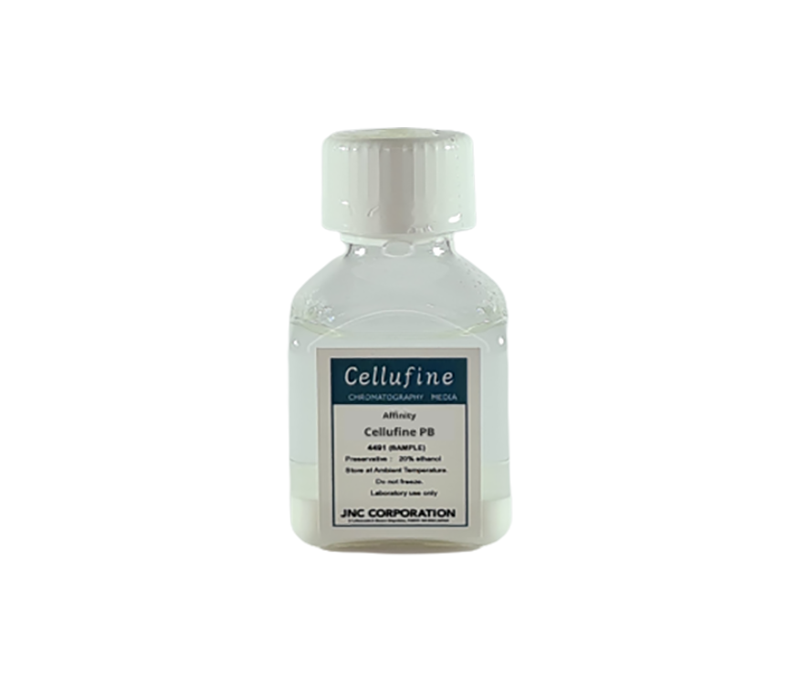
Cellufine™ PB
Cellufine PB is an affinity medium designed for concentration, purification of glycoprotein, glycated protein, saccharide. This media is made of spherical, rigid cellulose beads functionalized with phenyl borate. The phenyl borate groups give unique chromatographic selectivity for cis-diol groups of the target molecule.
-
Characteristics Ligand Phenyl borate Boron Contents 700μg/dry gel Binding capacity(Conalbumin) 10mg/ml Bead matrix Spherical Cellulose pH stability 3 to 12 Storage +2º C to +8º C in 20% ethanol -
- Operates at high flow rates.
- Acid and alkali stable
- Performance remains constant over at least 200 operating cycles.
- Autoclavable

Cellufine Phosphate
Cellufine Phosphate is an affinity media designed for concentration, purification of proteins and, enzymes such as nucleic acid related proteins. The base of the media is spherical and rigid cellulose functionalized with Phosphate esters. Cellufine™ Phosphate belongs to the new Cellufine™ series and has spherical porous beads. Unlike the conventional resin made from fiber, Cellufine Phosphate resin is able to withstand high pressure and is consequently used in large-sized columns with high flow rate.
-
Characteristics Support Matrix Cellulose Ligand Phosphate ester Ligand conc. 0.3 - 0.8meq/ml Adsorption Capacity ≧ 20mg/ml-gel (lysozyme)
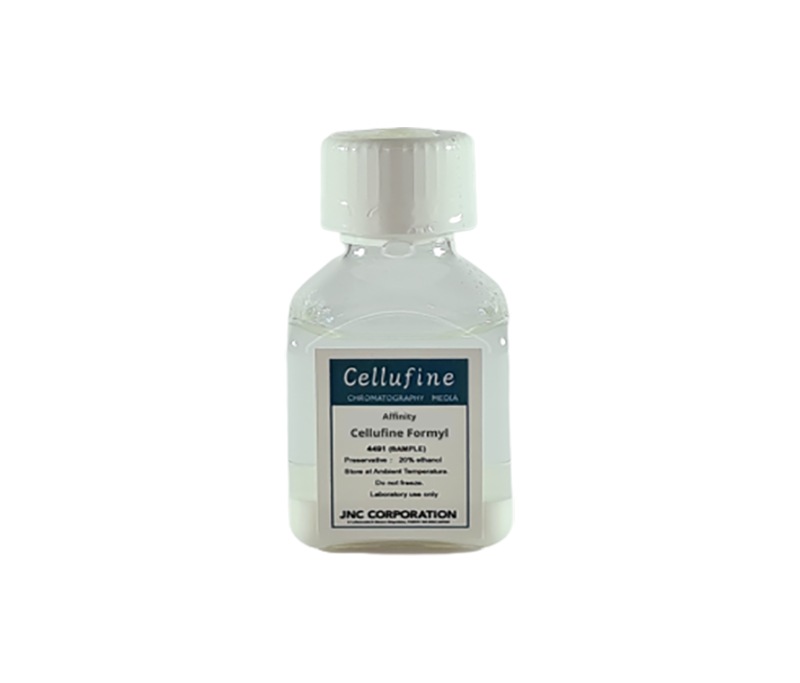
Cellufine Formyl
The growth of process-scale affinity chromatography has created the need for a new generation of support matrix materials and coupling chemistries suited for the industrial environment. Classical agarose-based supports perform poorly at the large-scale for several reasons. They provide poor flow properties in large columns. The widely used cyanogen bromide coupling chemistry has well-documented problems with bond stability and non-specific adsorption. Additionally, even with more modern chemistries, agarose can shed polysaccharide chains, giving rise to significant ligand leakage under mild operating conditions. Cellufine activated supports provide state-of-the-art laboratory performance at the process-scale without difficulty. The products are based on rigid spherical cellulose beads specially optimized for affinity chromatography to provide very large pore size and high ligand capacity together with high flow rates in large columns. The cellulose backbone offers very low non-specific adsorption without the ligand leakage problems of agarose.
-
Characteristics Substrate Crosslinked cellulose MW Exclusion Limit 4,000kD Standard Particle Size 125 - 210µm Particle Shape Spherical Density 0.7g/ml wet Shrinkage / Swelling Will not shrink or swell substantially under changes in pH or ionic strength Chemical Resistance Can be used with any salts, non-ionic detergents, organic solvents. Resistant to 0.1M HCl and 0.5M NaOH. (Note: coupled ligand may not be stable under these conditions) Mechanical Resistance Will withstand peristaltic pumping and extended mixing Autoclavable 121 °C for 30 minutes at pH 7 Saturation Capacity Up to 40mg protein/ml depending upon protein and conditions Operating Pressure < 1 bar (15 psi) Supplied Formyl 0.01 % 2, 2-thio-bis (pyridine-1-oxide) -
- High flow rates in laboratory and process columns for high throughput
- Low ligand leakage
- Excellent mechanical, chemical and environmental resistance
- High ligand loading capacity
- Compatible with high molecular weight ligands and target proteins due
- Unreacted formyl groups easily converted during reduction to neutral hydroxyls
- Built in hydrophilic spacer arms for maximum ligand accessibility and low non-specific adsorption
- No media damage or fines generation with extended mixing
- Thermal stability of media allows high temperature reactions
- Long shelf-life of unreacted media
Hydrophobic Interaction Chromatography Media
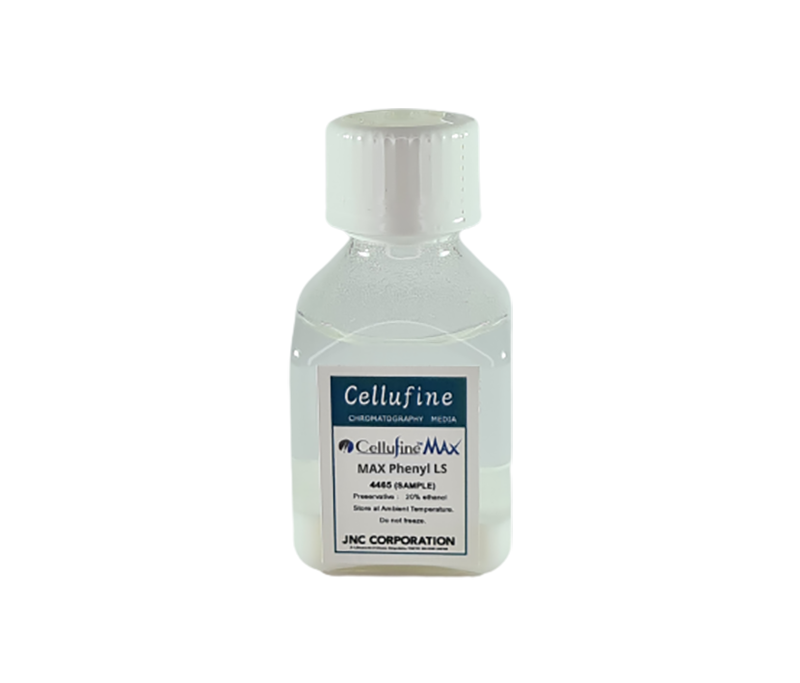
Cellufine™ MAX Phenyl & Cellufine™ MAX Phenyl LS
Cellufine MAX Phenyl is useful for the chromatography of hydrophobic proteins. Many proteins have hydrophobic amino acid residues which will interact with the phenyl functional groups. Factors that influence this hydrophobic interaction include salt concentration, temperature, pH, organic solvents and surfactants. Protein adsorption usually occurs at high ionic strength, while elution occurs at lower salt concentrations. This is the opposite of ion exchange chromatography and offers complementary separation benefits.
-
Cellufine MAX Phenyl Cellufine MAX Phenyl LS Support matrix Highly cross-linked cellulose Particle shape Spherical Particle diameter (μm) ca. 40 – 130 Ligand type Phenyl BSA capacity (mg/ml) 14 6 BSA elution efficiency (%) 40 90 Polyclonal IgG 10% DBC (mg/ml) 31 19 MW exclusion limit (kD) 1,000 pH stability range 2 – 13 Operating pressure < 0.3 MPa Supplied suspension in 20 % EtOH -
- Cellufine MAX Phenyl products have superior flow-pressure properties.
- Cellufine MAX Phenyl LS has lower ligand density than standard MAX Phenyl.
- Cellufine MAX media enables high-flow operation,
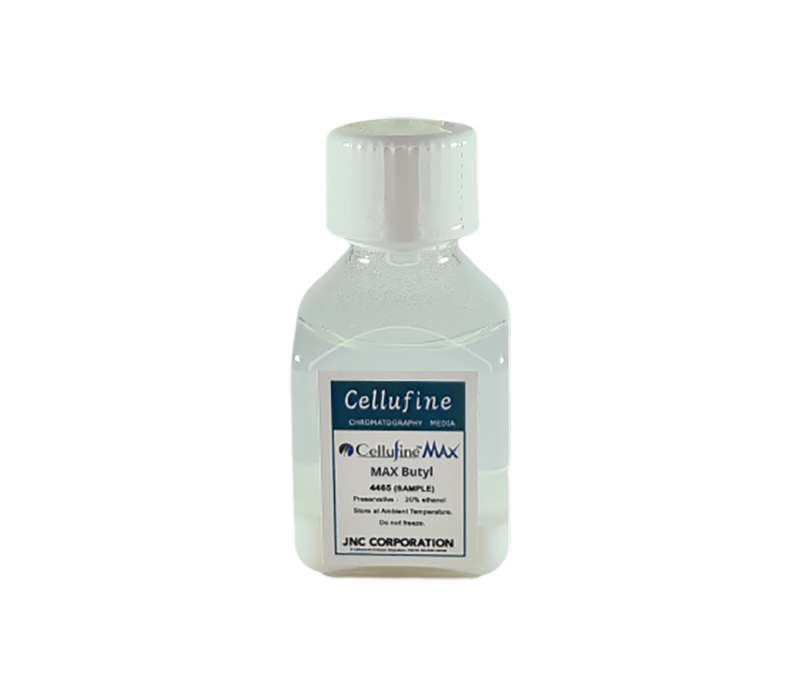
Cellufine™ MAX Butyl
Cellufine MAX Butyl is useful for the chromatography of hydrophobic proteins. Many proteins have hydrophobic amino acid residues which will interact with the butyl functional groups. Factors that influence this hydrophobic interaction include salt concentration, temperature, pH, organic solvents and surfactants. Protein adsorption usually occurs at high ionic strength, while elution occurs at lower salt concentrations. This is the opposite of ion exchange chromatography and offers complementary separation benefits.
-
Characteristics Support matrix Highly cross-linked cellulose Particle shape Spherical Particle diameter (μm) ca. 40 – 130 Ligand type Butyl BSA capacity (mg/ml) 9 BSA elution efficiency (%) 70 Polyclonal IgG 10% DBC (mg/ml) 17 MW exclusion limit (kD) 1,000 pH stability range 2 – 13 Operating pressure < 0.3 MPa Supplied suspension in 20 % EtOH
Ion Exchange Chromatography Media (IEX)
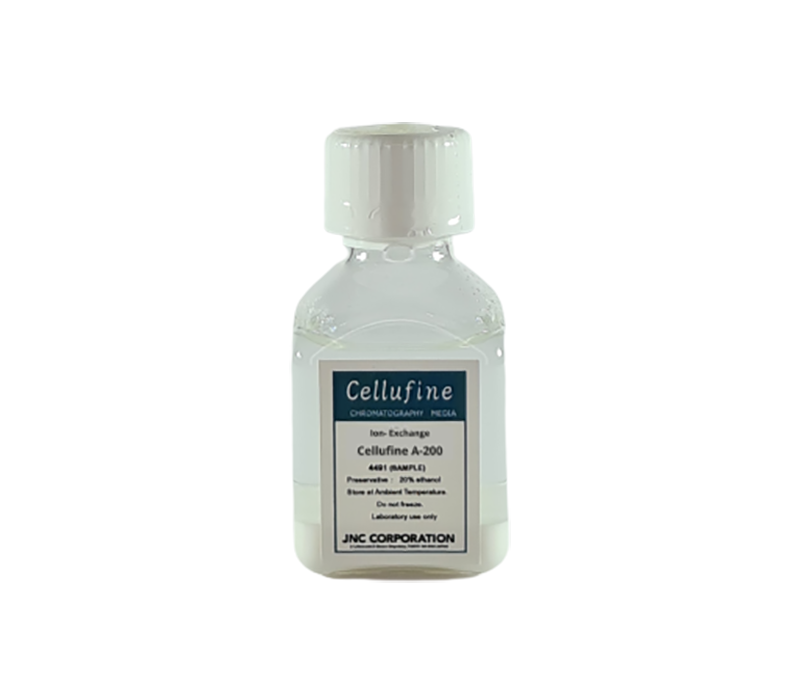
Cellufine A-200, A-500 and A-800
Cellufine A-200, A-500 and A-800 media are designed for the anion exchange chromatography of proteins, peptides and other biomolecules. The media are comprised of beaded spherical cellulose, functionalized with DEAE (diethylaminoethyl). The pore size and structure of each packing determines its respective applications. Cellufine A-200 medium is ideal for the chromatography of low molecular weight peptides or proteins (< 30kD), A-500 for proteins up to 500 kD and A-800 for use with larger biomolecules up to 1000 kD. The superior rigidity of Cellufine media allows for high flow rates, and thus, rapid processing times.
-
Cellufine A-200 Cellufine A-500 Cellufine A-800 Support matrix cellulose Particle shape spherical Particle diameter (μm) ca. 40 – 130 Ion capacity (meq/g dry) 0.9 1.3 0.8 MW exclusion limit (kD) 30 500 1000 Swelling degree (ml / g dry media) 6-9 8-10 12-16 pH stability range 1 - 13 Tapped volume (ml / g succession media) 1.3 – 1.5 1.3 – 1.5 1.4-1.6 Operating pressure < 2 bar (29 psi) Supplied suspension in 20 % EtOH
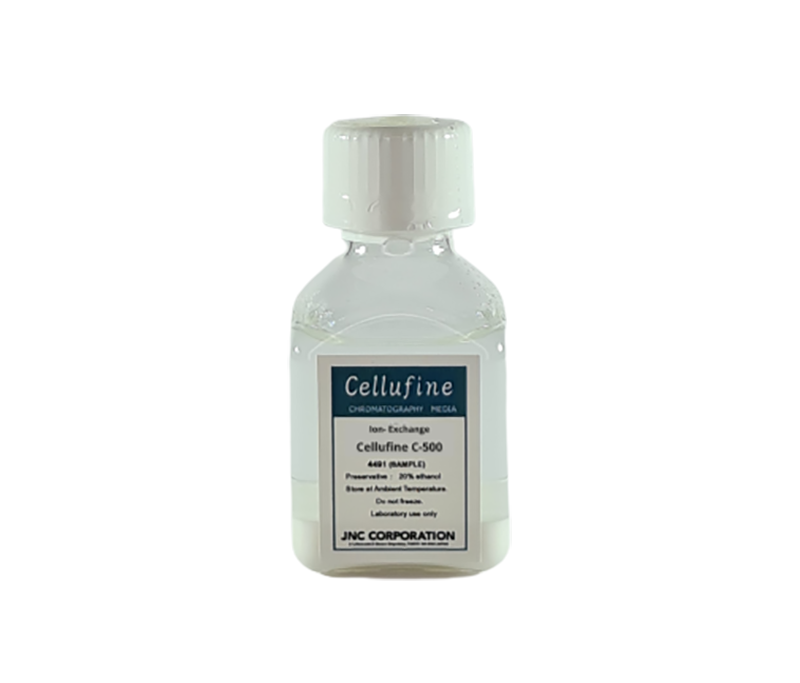
Cellufine C-500
Cellufine C-500 media manufactured by JNC Corporation are designed for the cation exchange chromatography of basic proteins and other biomolecules. The resins are comprised of beaded spherical cellulose, functionalized with carboxymethyl (CM). Cellufine C-500 medium is ideal for the chromatography of proteins molecular weight up to 500 kD. The superior rigidity of Cellufine gels allows for high flow rates, and thus rapid processing times, even in large diameter process scale columns.
-
Characteristics Support matrix Cellulose Particle shape Spherical Particle diameter (μm) ca. 40 – 130 (Ave.; 90μm) Ion capacity (meq/g dry) 0.9-1.2 Swelling degree (ml / g dry media) 9–11 MW exclusion limit (kD) 500 pH stability range 1 – 13 Operating pressure < 2 bar (29 psi) Tapped volume (ml / g succession media) 1.3 – 1.5 Supplied suspension in 20 % EtOH

Cellufine Q-500
Cellufine Q-500 media is designed for the anion exchange chromatography of acidic proteins, peptides and other biomolecules. The resins are comprised of beaded spherical cellulose, functionalized with a quaternary amine (trimethy-laminoethyl). The pore size and structure of each media determines its respective applications. Cellufine Q-500 medium is ideal for molecules up to 500 kD. The improved rigidity of Cellufine allows for high flow rates, and thus, rapid processing times, even in large diameter process scale columns.
-
Characteristics Support matrix cellulose Particle shape spherical Particle diameter (μm) ca.40 – 130 Ion capacity (meq/g dry) 1.5 BSA capacity (mg/ml) > 10 MW exclusion limit (kD) 500 pH stability range 2 - 12 Operating pressure < 2 bar (29 psi) Supplied suspension in 20 % EtOH
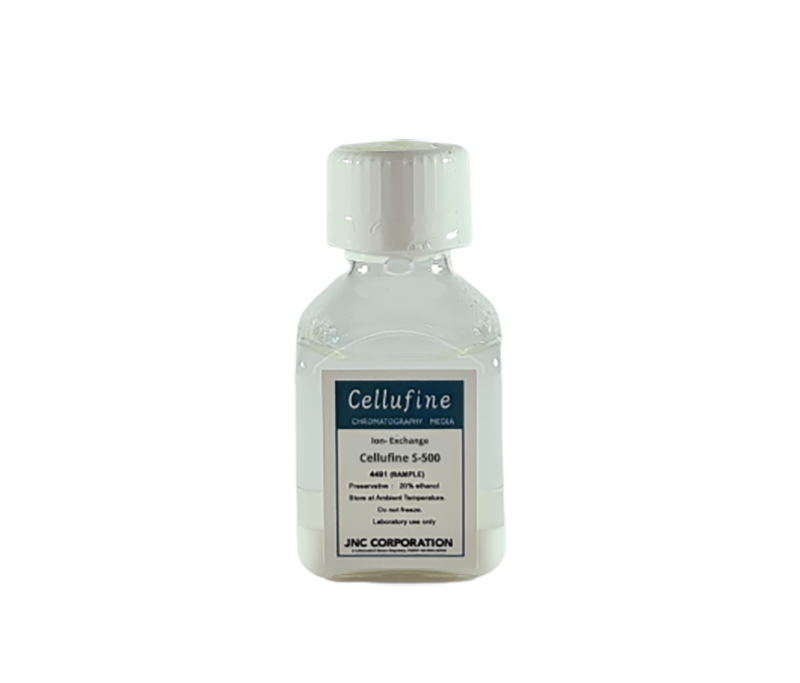
Cellufine S-500
Cellufine S-500 media manufactured by JNC are designed for the cation exchange chromatography of basic proteins and other biomolecules. The resins are comprised of beaded spherical cellulose, functionalized with sulfobutyl as the ligand. Cellufine S-500 medium is ideal for the chromatography of proteins with molecular weight up to 500 kD. The superior rigidity of Cellufine gels allows for high flow rates, and thus rapid processing times, even in large diameter process scale columns.
-
Cellufine S-500 Support matrix Cellulose Particle shape Spherical Particle diameter (μm) ca. 40 – 130 (average 90) Ion capacity (meq/mL) 0.11 – 0.22 MW exclusion limit (kD) 500 pH stability range 2 – 13 Operating pressure < 0.2 MPa Supplied suspension in 20 % EtOH
Ion Exchange Chromatography Media MAX (IEX MAX)
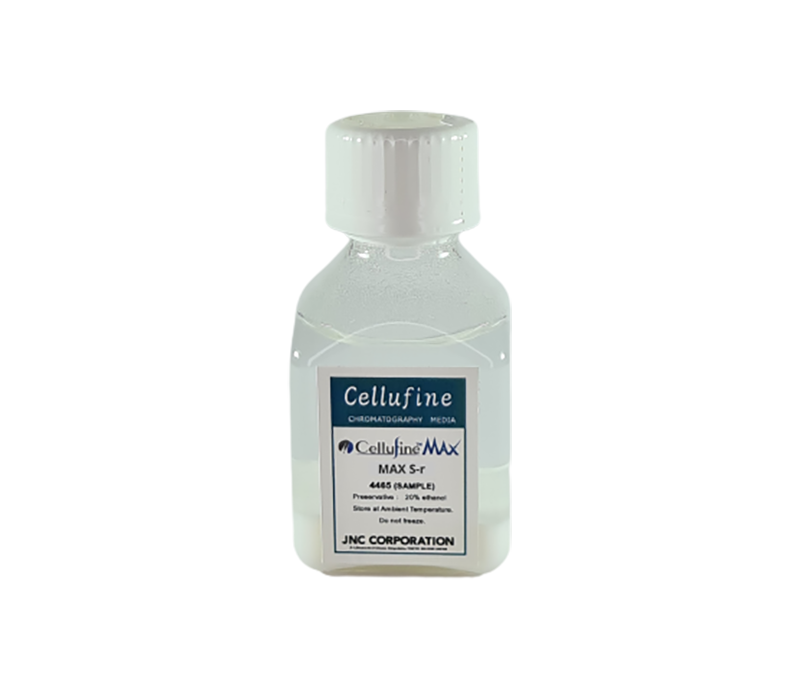
Cellufine MAX S-r & Cellufine MAX S-h
Cellufine MAX is the new name of 2nd generation Cellufine chromatography media. Cellufine MAX S strong ion exchangers are highly cross-linked, surface modified media with high dynamic binding capacities and stable at high flow velocities. These high performances of the optimized media offer significant opportunity for increasing downstream purification throughput. The characteristics of Cellufine MAX “-r” is high recovery, high resolution and robustness. The characteristic of Cellufine MAX “-h” is the highest adsorption capacity in present products.
-
Type Cellufine MAX GS Ion exchange type Strong cation (graft polymer type) Matrix Highly cross-linked cellulose Particle size ca.40–130μm (Average90) Ion exchange capacity 0.09~0.15 m mol /ml Flow velocity 600 cm/h(0.3 MPa) I.D.30 cm-L 20 cm, pure water at 24 oC Adsorption capacity ≧100 mg / ml (Lysozyme) Dynamic binding capacity ≧70 mg /ml (Polyclonal IgG 10 % DBC) pH stability (20oC, 1week) 2 – 13 Chemical stability Stable all commonly used aqueous buffers, 0.5 M NaOH Storage 20 % ethanol
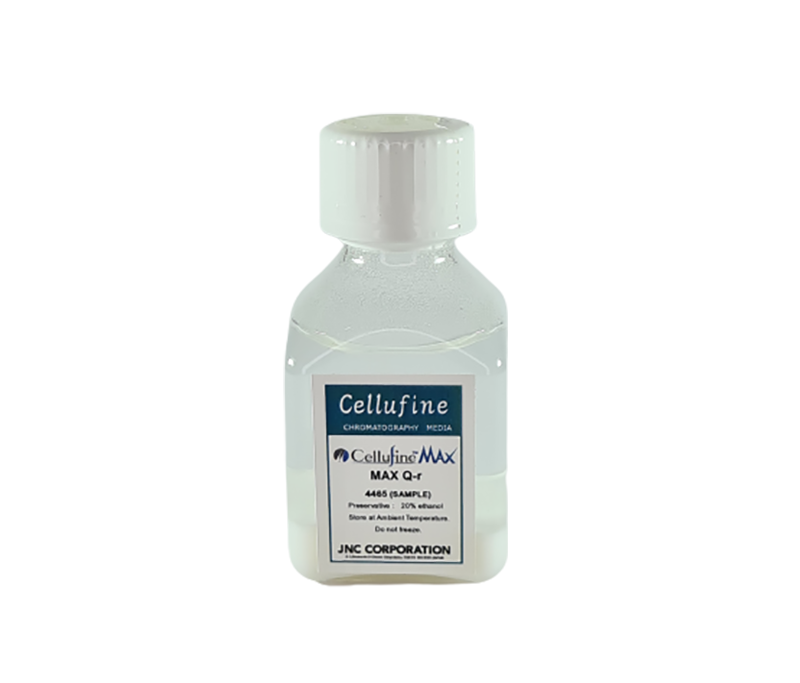
Cellufine MAX Q-r & Cellufine MAX Q-h
Cellufine MAX is the new 2nd generation Cellufine chromatography media. Cellufine MAX Q strong ion exchangers are highly cross-linked, surface modified media with high dynamic binding capacities and stability at high flow velocities. These high-performance optimized media offer significant opportunity for increasing downstream purification throughput. The characteristics of Cellufine MAX “-r” sires are high recovery, high resolution and robust. The characteristic of Cellufine MAX “-h” is the highest adsorption capacity in present products.
-
Type Cellufine MAX Q-r Cellufine MAX Q-h Ion exchange type Strong Anion / -N+(CH3)3 Matrix Highly cross-linked cellulose with dextran scaffold Particle size ca. 40 – 130 μm (Average 90) Ion exchange capacity 0.10~0.20 meq /ml 0.13~0.22 meq /ml Flow velocity 600 cm/h(0.3 MPa) I.D.30 cm-L20 cm, pure water at 24 oC Dynamic binding capacity > 110 mg BSA/ml > 180 mg BSA/ml pH working range 2 – 12 2-12 pH stability (40oC, 1week) 2-12 2-12 Chemical stability Stable all commonly used aqueous buffers, 1 M NaOH Storage 20 % ethanol
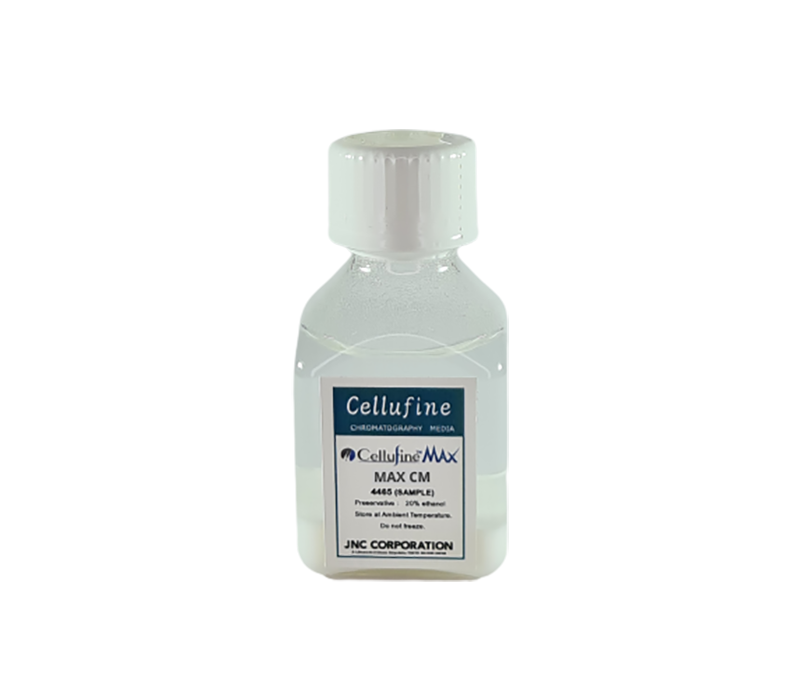
Cellufine MAX CM
Cellufine MAX is the new 2nd generation Cellufine chromatography media. Cellufine MAX CM weak cation exchanger is highly cross-linked, surface modified media with high dynamic binding capacities and stable at high flow velocities. These high performances of the optimized media offer significant opportunity for increasing downstream purification throughput.
-
Type Cellufine MAX CM (carboxymethyl) Ion exchange type Weak cation / -CH3COOH Matrix Highly cross-linked cellulose with dextran scaffold Particle size ca. 40 – 130 μm (Average 90 μm) Ion exchange capacity 0.09~0.22 meq /ml Flow velocity 600 cm/h(0.3M pa) I.D.30 cm-L 20 cm, pure water at 24 oC Dynamic binding capacity >120 mg Lysozyme / ml gel pH stability (20oC, 1week) 2 – 13 Chemical stability Stable all commonly used aqueous buffers, 0.5 M NaOH Storage 20 % ethanol
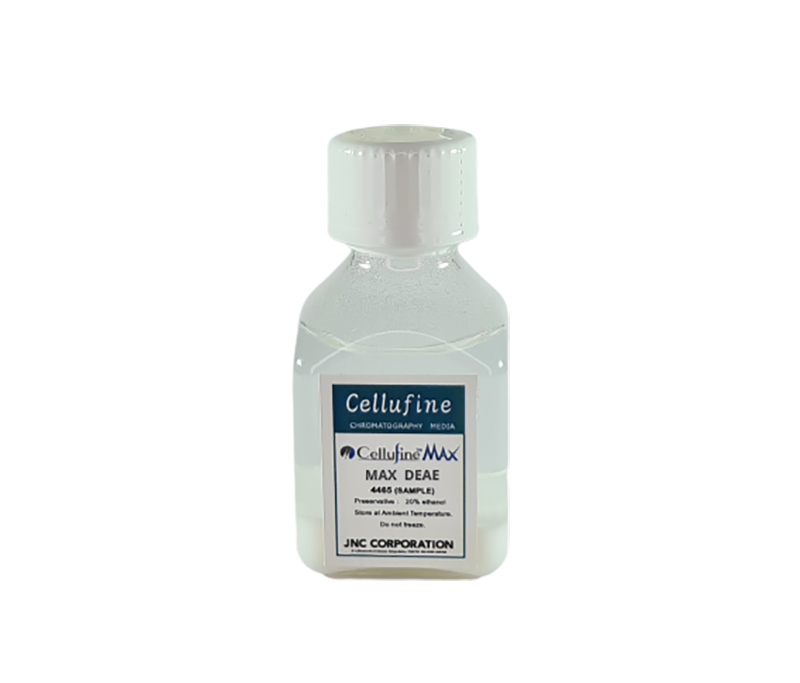
Cellufine MAX DEAE
Cellufine MAX is the new 2nd generation Cellufine chromatography media. Cellufine MAX DEAE weak anion exchanger is highly cross-linked, surface modified media with high dynamic binding capacities and stable at high flow velocities. These high performances of the optimized media offer significant opportunity for increasing downstream purification throughput.
-
Type Cellufine MAX DEAE (diethylaminoethyl) Ion exchange type Weak anion/ -CH2CH2-N(CH2CH3)2 Matrix Highly cross-linked cellulose with dextran scaffold Particle size ca. 40 – 130 μm (Average 90) Ion exchange capacity 0.12~0.22 meq /ml Flow velocity 600cm/h(0.3Mpa) I.D.30cm-L 20cm, pure water at 24oC Dynamic binding capacity >120 mg BSA/ml gel pH stability (20oC, 1week) 2 – 12 Chemical stability Stable all commonly used aqueous buffers, 0.5 M NaOH Storage 20 % ethanol

Cellufine MAX S-r & Cellufine MAX S-h
Cellufine MAX is the new name of 2nd generation Cellufine chromatography media. Cellufine MAX S strong ion exchangers are highly cross-linked, surface modified media with high dynamic binding capacities and stable at high flow velocities. These high performances of the optimized media offer significant opportunity for increasing downstream purification throughput. The characteristics of Cellufine MAX “-r” is high recovery, high resolution and robustness. The characteristic of Cellufine MAX “-h” is the highest adsorption capacity in present products.
-
Type S-r S-h Ion exchange type Strong cation / -SO3- Matrix Highly cross-linked cellulose with dextran scaffold Particle size ca. 40 – 130 μm Ion exchange capacity 0.09 ~ 0.21 meq /ml 0.10 ~ 0.22 meq /ml Flow velocity 600 cm/h(0.3 MPa) I.D.30 cm-L 20 cm, pure water at 24oC Dynamic binding capacity > 130 mg IgG /ml gel > 180 mg IgG /ml gel pH working range 2 – 13 3 - 14 pH stability (40oC, 1week) 2 – 14 3 - 14 Chemical stability Stable all commonly used aqueous buffers, 1 M NaOH Storage 20 % ethanol -
- Safety Data Sheet : https://www.jnc-corp.co.jp/fine/en/cellufine/guide/pdf/ion_max/SDS_MAX_S_USA_20150911.pdf
- Operating instructions : https://www.jnc-corp.co.jp/fine/en/cellufine/guide/pdf/ion_max/OI_MAX_S_V5_E.pdf
- Technical Data Sheet : https://www.jnc-corp.co.jp/fine/en/cellufine/guide/pdf/ion_max/TD_MAX_IEX_N1_V4_E.pdf
- Leaflet : https://www.jnc-corp.co.jp/fine/en/cellufine/guide/pdf/ion_max/CA_MAX_CIEX_N1_V2_E.pdf

Cellufine MAX GS
Cellufine MAX is the new 2nd generation Cellufine chromatography media. Cellufine MAX GS strong cation exchanger is highly cross-linked media with stable at high flow velocities and with optimized ligand density. These high performances offer significant opportunity for increasing downstream purification throughput, especially aggregate removal from therapeutic molecular antibodies.
-
Type Cellufine MAX GS Ion exchange type Strong cation (graft polymer type) Matrix Highly cross-linked cellulose Particle size ca.40–130μm (Average90) Ion exchange capacity 0.09~0.15 m mol /ml Flow velocity 600 cm/h(0.3 MPa) I.D.30 cm-L 20 cm, pure water at 24 oC Adsorption capacity ≧100 mg / ml (Lysozyme) Dynamic binding capacity ≧70 mg /ml (Polyclonal IgG 10 % DBC) pH stability (20oC, 1week) 2 – 13 Chemical stability Stable all commonly used aqueous buffers, 0.5 M NaOH Storage 20 % ethanol
Mix Mode Chromatography Media
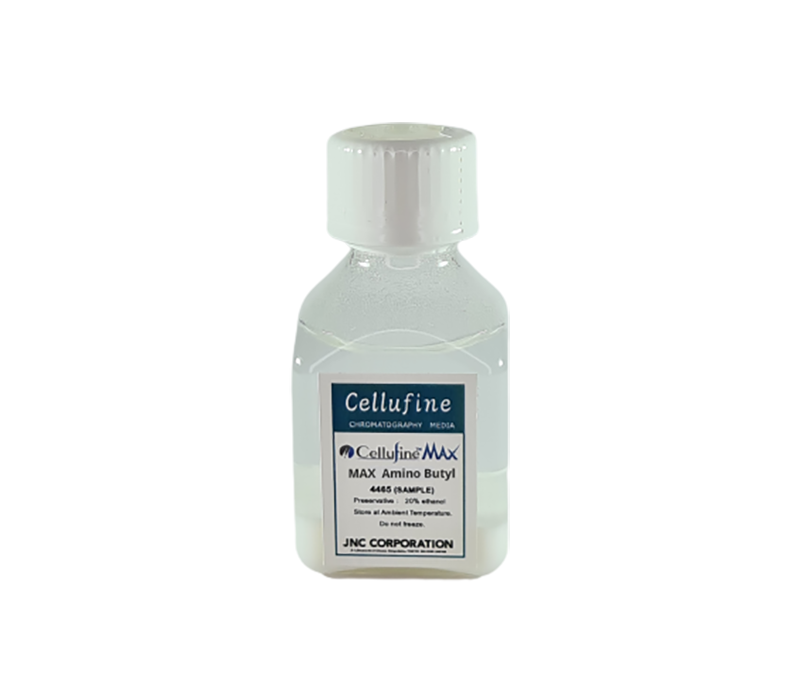
Cellufine MAX AminoButyl
Mixed mode chromatography media are well-known to have unique selectivity differences from traditional IEX or HIC resins. JNC corporation has developed a new mix-mode resin, Cellufine MAX AminoButyl, for virus or virus like particles (VLPs) purification. This resin has both salt tolerant primary amine and hydrophobic butyl group as ligands. Especially ligand density of butyl group is optimized for adsorption/desorption of VLPs having strong hydrophobicity. This mixed mode resin is built on the cross-linked Cellufine cellulose base bead that is very stable, resistant to base CIP and can be operated under high flow modes with minimal back pressure.
-
Characteristics Matrix Highly cross-linked cellulose Particle size 90μm (40 – 130 μm) Ligand Butyl + primary Amine Protein adsorption (1) in 2M (NH4)2SO4 α-Chymotripsinogen A; + Ribonuclease A; - Lysozyme; - Protein adsorption (2) in 20 mM Tris-HCl (pH7.5) Transferrin; - BSA; + Pepsin; +
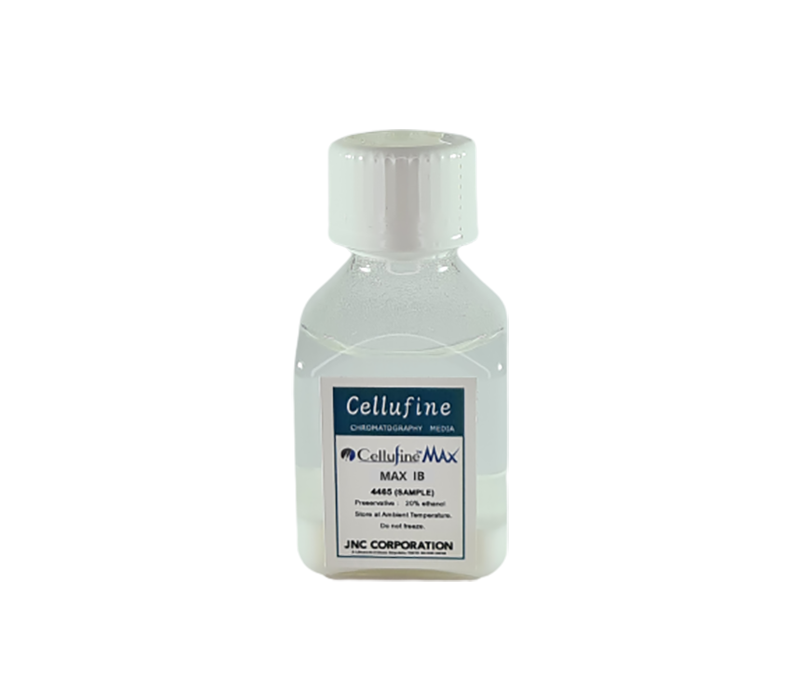
Cellufine MAX IB
Mixed mode chromatography resins are well-known to have unique selectivity differences from traditional IEX or HIC resins. JNC Corporation has developed a new mix-mode resin, Cellufine™ MAX IB, for monoclonal antibody (Mab) purification after initial rProtein A capture. This resin has a salt tolerant polyallylamine surface modification that has been partially modified with butyl groups. The resulting ligand structure exhibits a mixed mode functionality with a hybrid primary amine + butyl surface chemistry. In addition to the Mab polishing application this resin can be used in other downstream processes, such as plasma fractionation exploiting the unique selectivity of this mixed-mode ligand. This mixed mode resin is built on the cross-linked Cellufine cellulose base bead that is very stable, resistant to base CIP and can be operated under high flow modes with minimal back pressure.
-
Properties Value Base bead matrix Highly cross-linked cellulose Particle size 90 µm average Microscopic test < 5 % Ion Exchange capacity 0.10 - 0.16 meq/ml BSA Adsorption capacity ≥ 60 mg/ml Operating pressure < 0.3 MPa -
- Flow-through polishing format
- High salt tolerance up to 0.2M NaCl
- High clearance of CHO-HCP, leached rProtein A and residual dsDNA
- Reduction of Mab aggregates to < 1%
- Rapid two-step capture and polishing workflow format
Gel Filter Action Chrom Media
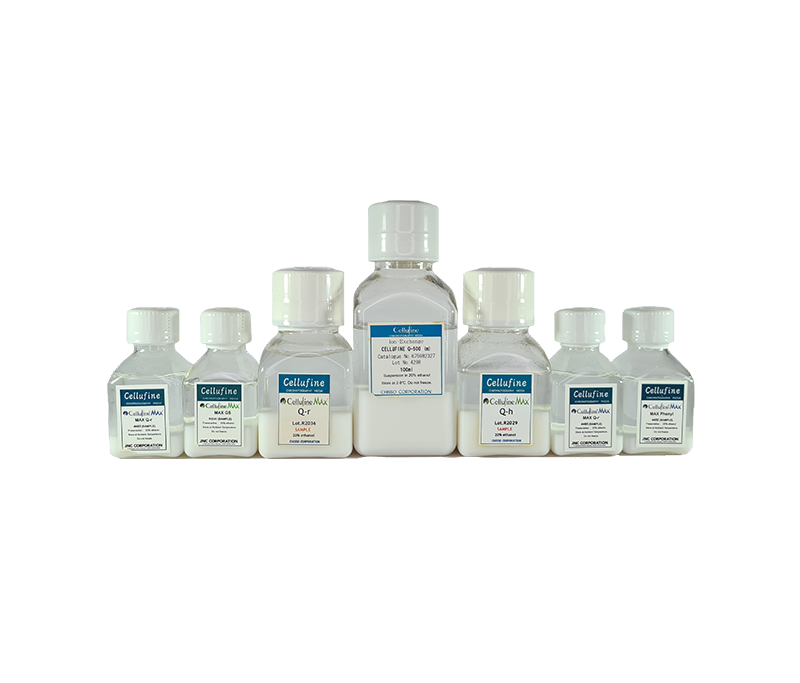
Cellufine™ GCL-2000 & GCL-2000HF
Gel Filtration, or size exclusion chromatography, has proven to be a simple and effective purification method for proteins and other biomolecules. However, the traditionally slow flow rates and limiting resolving power of most gel filtration media have restricted its usefulness. JNC’s Cellufine GCL media has been designed to overcome these limitations. The mechanical strength of the spherical cellulose matrix allows high flow rates, even in large industrial columns
-
Cellufine GCL-2000 HF which is high-flow type and has a same porosity characteristic with Cellufine GCL-2000. Cellufine GCL-2000HF offers competitive flow rate and resolving power for gel filtration chromatography. The semi-rigid spherical cellulose beads exhibit good flow rates with longer bed length, even with large diameter columns, while the high pore volume allows high capacity. Furthermore, GCL-2000 is chemically stable and can be run with many buffers and solutions.
-
Characteristics Matrix Cross linked cellulose Particle Shape Spherical Particle Size ca. 40-130 μm Chemical Resistance Media can be used with most salts, detergents, solvents, acids and bases, including 8M urea, 6M guanidine / HCL, 0.1M HCL and 0.5M NaOH Mechanical Resistance Media will withstand peristaltic pumping and extended magnetic stirring Schrinkage / Swelling Shrinkage or swelling < 3 % with changes in pH or ionic strength. Shrinkage or swelling with solvents varies with solvent and media Autoclavable 121 °C for 30 minutes Supplied Suspension in 20 % ethanol -
- Outstanding mechanical strength
- High pore volume
- Supplied preswollen
- High chemical resistance
- Autoclavable at 121 °C for 30 minutes

Cellufine GH-25
Cellufine GH-25 provides a rapid means of salt removal and buffer exchange for protein solutions. The semi-rigid spherical cellulose beads allow high flow rates with little compression of the column bed. The separation mechanism is based on differential solute access into the chromatographic bead. Whereas large molecules (above 3 kD) are excluded from the packing and pass quickly through the column, small molecules (salts) diffuse into the bead and are thus retained longer. GH-25 can be used to remove alcohols, salts, detergents, fluorochromes, sugar, etc., from virtually any protein solution. It is compatible with most solvents and is stable from pH 1 - 14.
-
Characteristics Matrix Crosslinked cellulose Particle Size ca. 40-130 μm Gel Exclusion Limit 3kD Autoclavable 121 °C, 30 min. Pressure Resistance No collapse at up to 870 ml/h/cm2 flow in large columns pH Stability pH 1 – 14 Chemical Resistance Resistance to detergents and dissociating agents. No change after 30 days in 0.1M HCl or 0.1M NaOH. Supplied Suspension in 20 % ethanol -
- Mechanical robust spherical particle
- Efficient salt removal
- Hydrophilic
- Low non-specific adsorption, high recovery
- pH stable 1 – 14 (0.1M HCl, 0.5M NaOH)
- Resistant to organic solvents
- Easy cleaning and depyrogenation
- Autoclavable (121 °C, 30 min)
© Mr Sanghavi & co. All Rights Reserved | Terms & Conditions | Privacy | Crafted & Digitized by Xtrovertz
